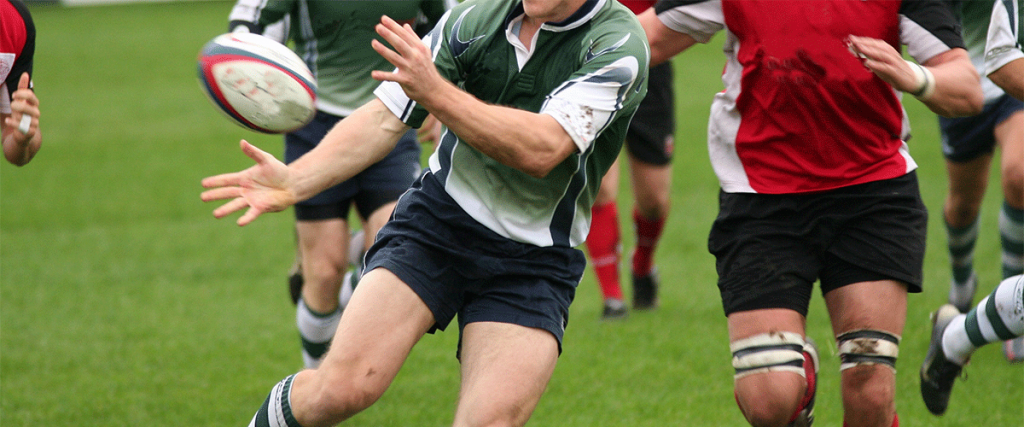The most basic ability in rugby is passing and catching the ball, but many new players fail because they are never properly taught how to do it. In light of it, I created this short article of how to pass a rugby ball. We’ll go through the fundamentals of passing and catching first, and then we‘ll examine each of the four basic sorts of passes in more detail.
How to pass a rugby ball

Run ahead while holding the ball in two hands in front of you. Choose the target by casting your gaze in the direction you want to pass. Before swinging your arms directly in the direction of your intended target, draw the ball back slightly in the other direction from where you intend to pass it. Then, release the ball just before your arms fully extend.
Now, let’s elaborate on that a little more on how to pass a rugby ball:
Prior: The player’s hands should be placed across the seams of the ball on either side, holding the ball with two hands. Keep racing straight to fix a defender instead of giving in to the want to drift towards the player you are passing to because the passer will typically be moving forward.
During: Pass at chest height in the direction of the receiver, where the receiver should be extending out his or her hands as a target. Look at the receiver you are passing to while continuing to run towards the defender’s inner shoulder.
After: Continue with the arms until they are finished pointing directly at the target. Giving them another choice, loop around to get a supporting line from the ball carrier.
Tip: Players should be equally adept at passing off both hands, so make sure you practice passing more often with your weaker hand.
Taking A Rugby Pass

Not just in front of you, but also in the direction of the pass, should hands be extended. With the arms almost fully extended and hands held loosely and softly with fingers pointed in the direction of the ball. The ball should be kept in focus until it is safely in your hand.
Let’s go into greater detail now:
Before: At chest height, extend your hands in the direction of the ball and the passer. You should alternate between watching the passer and scanning the defensive line in front of you all the time.
During: Keep a close eye on the ball as it travels through the air and into your hands, and move directly onto it. Resist the urge to chase after the ball or veer off course unless it is part of a deliberate motion.
After: The receiver must choose whether to pass, run, kick, or make contact with the ball. Depending on their choice, they will either continue holding the ball in two hands or just one, and on which side of their bodies.
Tip: The defender may decide to focus on the ball in flight after it is in the air. The attacker can aim to drift outside the defense as they are doing this to change positions while the defender is not looking, giving them an extra yard or two to work with. This was Brian O’Driscoll’s specialty.
How To Pass A Spin

The top hand rolls over the top of the ball in a motion similar to passing, giving the ball both power and spin. Direction and control are guided by the bottom hand. The arms must extend fully toward the target with a follow-through from both hands.
The spiral (spin) of the ball significantly assists it to move further and faster than a non spiral pass with this style of pass, which is fantastic for passing the ball longer distances. Let’s dissect it further:
Prior: Firmly lay your hands on either side of the ball, across the seam, to catch or hold it in two hands. In order for the player to receive the ball moving forward, look for the receiver and where the ball needs to be passed to. If you are passing over a greater distance, you will be aiming for the area some distance in front of the player.
During: Swing your arms in the direction of your goal, using your top hand to provide force and spin and your bottom hand to direct the ball.
After: Continue your arm swing so that your hands are extended and pointed directly towards the target. This motion ought to provide a snapping sensation.
Tip: Don’t spiral pass over shorter distances since the receiving player might not be able to catch it because of how quickly the ball travels through the air.
Passing Off The Ground

Swoop down, pointing the passing foot at the receiver while keeping it close to the ball. Swing your arms through to full extension directly at the receiver as you grasp the ball across the seam, shift your weight to your passing foot, and give the ball power and spin with your top hand.
At the base of a ruck or scrum, the scrum half typically makes this pass, but any player may find themselves in a position where they must use this technique to quickly move the ball away from the base. Let’s elaborate on the specifics further:
Pior: As you plant the passing foot near to the ball and take a wide stance, bend at the knees and sink at the hips. The head should be positioned over the ball, and the leading foot should aim in the direction of the desired recipient.
During: Swing your arms without lifting your back toward the target while remaining in this stance or as you move into it. Grip the ball across the seam with both hands. Use the bottom hand for direction and the top hand for strength. Throughout this movement, weight should be transferred to the leading foot.
After: Continue straight forward toward the goal with your arms and hands, which should end up pointed in that direction. The delivery of scrum halves who do this as their day job has a great zip about it, with follow through being a fairly significant component of their technique.
Tip: Make careful to bend both your knees and your hips. The passing platform will become unstable if one or both are bent too much.
Conclusion
In summary, Rugby relies heavily on passes. How to pass a rugby ball really is by passing the ball to one another, players can help the ball advance up the field and toward the goal area. However, players must take care to prevent the ball from moving forward as they do this. This is the original rugby passing rule.
Please read: http://rugbyqa.com/ruck-rugby-and-the-interesting-rules-surrounding-it/

